History of the Modern Motorcycle Helmet
Helmets have been around pretty much throughout human history. Examples of helmets, presumably for military use, can be found in the pre-history of more than one culture. Helmets came in a wide variety of shapes and sizes to serve a range of protective functions long before motorcycle helmets were developed.In WWII the British Army issued helmets to their dispatch riders that were considerably different than other combat helmets, and riders were required by regulation to wear them. Those military regulations may be the first modern example of a helmet law, although the army may seem an unlikely proponent of safety precautions.
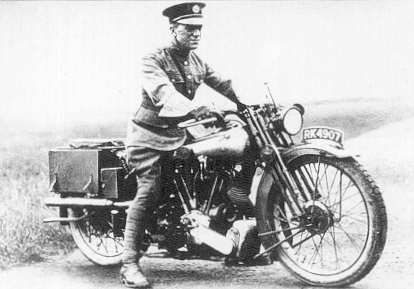 Sadly, many of what might be called the milestones in the development of the modern motorcycle helmet involve the death of a rider. Those who remain to remember the rider, seek change. The first rider whose demise we can point to as a milestone in the development of the modern motorcycle helmet is T.E. Lawrence, also known as Lawrence of Arabia. He died in 1935 from a head injury received crashing his Brough Superior SS100, a bike he received as a gift from George Bernard Shaw.
Sadly, many of what might be called the milestones in the development of the modern motorcycle helmet involve the death of a rider. Those who remain to remember the rider, seek change. The first rider whose demise we can point to as a milestone in the development of the modern motorcycle helmet is T.E. Lawrence, also known as Lawrence of Arabia. He died in 1935 from a head injury received crashing his Brough Superior SS100, a bike he received as a gift from George Bernard Shaw.
At the time, helmets were common only in motorcycle racing and were not often used on the roads. A young neurosurgeon named Hugh Cairns was present at the military hospital where T.E.Lawrence died, and he went on to begin the first systematic assessment of head injuries in motorcycle crashes, and the first studies on the efficacy of helmets. That research, and Cairns connection to the military lead to the superior head protection that British Military Motorcycle Couriers enjoyed.
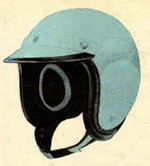 The modern motorcycle helmet, as essential to a rider as the bike, is still a long way in the future though, and civilian riders in the UK weren't required to wear helmets until the early 1970's. Between the 1900's and the 1960's motorcycle helmets were only required in racing or for police or military riders.
The modern motorcycle helmet, as essential to a rider as the bike, is still a long way in the future though, and civilian riders in the UK weren't required to wear helmets until the early 1970's. Between the 1900's and the 1960's motorcycle helmets were only required in racing or for police or military riders.
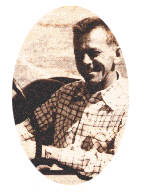 The next significant milestone in the development of the modern motorcycle helmet was marked by the death of a popular amateur car racer, William "Pete" Snell, who died in 1957 of head injuries his helmet failed to prevent. Helmets had long been required equipment in racing, for both motorcycle racers and car racers, but the construction and safety standards were varied and ungoverned. It's interesting that T.E.Lawrence's death without a helmet caused head injuries to be more carefully studied, but Snell's death while wearing a helmet caused helmets to be investigated more critically.
The next significant milestone in the development of the modern motorcycle helmet was marked by the death of a popular amateur car racer, William "Pete" Snell, who died in 1957 of head injuries his helmet failed to prevent. Helmets had long been required equipment in racing, for both motorcycle racers and car racers, but the construction and safety standards were varied and ungoverned. It's interesting that T.E.Lawrence's death without a helmet caused head injuries to be more carefully studied, but Snell's death while wearing a helmet caused helmets to be investigated more critically.
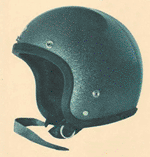 Hence I believe it can be argued that 1957 marks the birth date of the modern motorcycle helmet. As helmet testing and development along with head injury research developed a body of data, helmet legislation began to be considered sporadically across the USA through the 1960's and '70's. In Canada in the late '60's and in the UK in the early '70's.
Hence I believe it can be argued that 1957 marks the birth date of the modern motorcycle helmet. As helmet testing and development along with head injury research developed a body of data, helmet legislation began to be considered sporadically across the USA through the 1960's and '70's. In Canada in the late '60's and in the UK in the early '70's.
Helmet development has continued, arguably driven in part by the Snell Memorial Foundation's policy of revisiting helmet standards every 5 years. The quality and level of protection we get from our helmets today is the result of hardly more than half a century of development, and contributions from almost every branch of science.
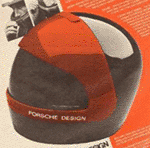 Probably most significant change between 1935 and now are the materials of which helmets are made, most of which would be completely unfamiliar to the military armorer of a century ago. None of the materials from which helmets are made now have a naturally occurring form, each one is manufactured. The armorer of a century ago would have recognized all the tools and materials of generations of predecessors, but hardly more than 50 years later, none of the materials or methods of construction would be recognizable.
Probably most significant change between 1935 and now are the materials of which helmets are made, most of which would be completely unfamiliar to the military armorer of a century ago. None of the materials from which helmets are made now have a naturally occurring form, each one is manufactured. The armorer of a century ago would have recognized all the tools and materials of generations of predecessors, but hardly more than 50 years later, none of the materials or methods of construction would be recognizable.
Bakelite, the first commercially successful plastic was invented in 1907, but fiberglass wasn't invented until 1938, and I haven't found mention of it in motorcycle helmet advertisements before the 1960's. A wide range of plastic, styrofoam and other chemically complicated construction materials have been used to make helmets since then. Finding out exactly what a helmet today is constructed from probably requires several degrees in chemistry. The third milestone in helmet development probably happened in a test tube or a labratory.
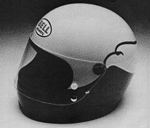 Only when good quality helmets were avaiable, and well researched data collected to show the value of a helmet to a motorcyclist, did the legislators get involved. By the 1980's helmet laws were enacted in many countries, although various states in the USA still periodically repeal helmet laws. Florida in particular offers us fatality and injury statistics sufficiently shocking to prevent similar legal changes in other jurisdictions.
Only when good quality helmets were avaiable, and well researched data collected to show the value of a helmet to a motorcyclist, did the legislators get involved. By the 1980's helmet laws were enacted in many countries, although various states in the USA still periodically repeal helmet laws. Florida in particular offers us fatality and injury statistics sufficiently shocking to prevent similar legal changes in other jurisdictions.
In these litiginous days, where helmet manufacturers are named in lawsuits in which their products were not used, it's remarkable we have any companies willing to make motorcycle helmets anymore. Without legislation requiring us to wear helmets, we probably wouldn't.
The next time you slide on your helmet, take a moment to value the complexity of the science and the people behind it's development; from the racers and doctors to the scientists and politicians.
More Photos...
Vintage motorcycle riding gear and motorcycle helmet advertisements from the 1950's to the 1980's - Riding Gear Ads
|
5 Reasons to replace your helmet: 1) it's over 5 years old 2) it's be crashed in 3) it's hit the ground from a height 4) you leave your helmet on a shelf, bike or table, and come back to find it on the ground 5) exposure to unknown solvents - you find a nasty liquid in your helmet |
More Helmet Reading...
Important reading for all helmet wearers: The Snell Memorial Foundation www.smf.orgFlorida's Motorcycle Helmet Law Repeal and Fatality Rates http://www.pubmedcentral.nih.gov/articlerender.fcgi?artid=1448295
Motorcycle Accident Studies and Helmet use: http://www.maids-study.eu/helmets.html
Head Protection and Injury information
Head protection research labratory: http://www.hprl.org/
DOT Helmet testing information:
Helmet testing data from 2007: http://www.nhtsa.dot.gov/cars/testing/comply/fmvss218/2007s218.pdfNHTSA DOT Helmet Recall information: http://www.nhtsa.dot.gov/cars/testing/comply/fmvss218/2007s218.pdf
More Helmet Information: Insurance Institute for Highway Safety (USA) on helmets for motorcyclists - http://www.iihs.org/research/qanda/helmet_use.html
Ontario Road Safety:
Ontario Road Safety Annual Reports http://www.mto.gov.on.ca/english/safety/orsar/

